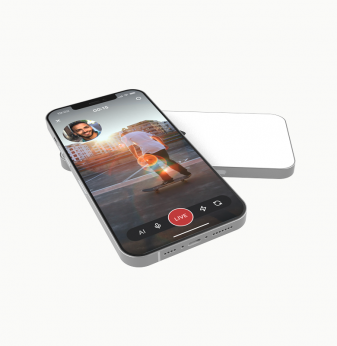Digital IPTV STB with DVB-T/S/S2 support
- Project Overview
At the order of the European company which develops consumer multimedia electronics, we have designed a digital IPTV STB with DVB-T and DVB-S/S2 support, based on the SMP8654 processor by SigmaDesigns. The system was fitted with a physical interface to work with smart cards.
While working on the project, we also assisted the customer in driver development and testing, which allowed for the special features of the STB hardware.Project summary In the process of developing the IPTV STB with DVB-T/S/S2 support, Promwad experts have performed the following tasks:
— Selection and cost optimization of an elements base
— Circuit diagram development
— Design concept and PCB routing
— Creation of design documentation
— Prototype debugging- How It's Made
Customer
A developer of consumer and multimedia electronics.
Objective
Development of an hybrid IPTV set-top box based on the SMP8654 media processor by SigmaDesigns, which supports DVB-T (Terrestrial Digital Video Broadcast) and DVB-S/S2 (Satellite Digital Video Broadcast) standards.
Solution
The main project tasks include:
- Selection and cost optimization of BOM (bill of materials).
- Schematics development.
- CAD design and PCB routing.
- Development of hardware design documentation.
- Prototypes test and bring-up.
The initial stage of the project involved examination and study of project options, considering the processor architecture and the STB functionality requirements. Based on the study, electronic components were selected for the project, taking into account implementation of peripheral interfaces.
1. Basic Platform Design Requirements
The set-top box should receive and decode signals in the 174-863 MHz frequency band for terrestrial broadcasting and in the 950-2150 MHz frequency band for satellite broadcasting. Supported format of video broadcast is MPEG-2/4 with SD and HD resolution (720х576 and 1920х1080).
The set-top box should be equipped with two CI CAM slots and a smartcard interface to decode encrypted channels, as well as two USB and SATA interfaces to connect external storage devices. Additionally, 10/100/1000 Mbps Ethernet and IEEE802.11b/g Wi-Fi interfaces should be implemented on the device for external network connectivity.
The set-top box should be connected to a TV through RCA connectors, a composite video output, a component video output and two audio channel outputs. In addition, the HDMI and SPDIF digital outputs should be implemented.
The set-top box should be equipped with a front-panel containing a VFD display and an IR receiver to receive remote control commands.
2. Circuit Design
The STB is powered by the SMP8654 processor by SigmaDesigns. It features an internal architecture based on a multi-kernel technology. Each kernel makes it possible to perform a wide variety of tasks. Thus the SMP8654 processor is an ideal solution for multimedia devices.
The SMP8654 has two independent memory controllers, which helps increase its overall productivity while processing data and running user applications simultaneously. The processor has several processing cores with hardware acceleration for video data processing. The SMP8654 can run on Linux or WinCE.
The set-top box uses two independent tuners to receive and decode DVB-T and DVB-S/S2 signals.
A number of tuners by various manufacturers were considered for the project. The choice was based on the following criteria: manufacturing cost, Linux driver support, signal reception parameters, modular design and an integrated demodulator.
To decode closed channels, the system uses two independent CI modules. The use of low-cost logical switches in the system helps switch traffic flows and send them to the CI modules. Due to hardware limitations (no asynchronous bus), configuration and management of the CI modules is achieved through a hardware bus simulator with I2C extenders.
A physical interface for smartcard communication was integrated on board.
An external PHY / MAC controller chip was used in the system to implement 10/100/1000 Mbps Ethernet because processor hardware error prevents the use of an internal MAC controller at a speed of 1,000 Mbps. A PCI bus was used to connect Ethernet controller to the processor. RJ-45 connector mounted on the rear panel was used to connect the system to a network.
The system was fitted with a mini PCI connector to connect PCI devices, which enabled the installation of a Wi-Fi module.
Four DDR2 chips, 128 Mb each, were used for program and data storage. Each memory controller had two integrated circuits connected to it.
The operating system was booted from external NAND Flash. Two NAND Flash chips were installed on the board, which enabled system backup and recovery.
A front-panel was connected to the main set-top box board through a UART interface. This solution helped control and program the microcontroller mounted on the front panel, which, in turn, displayed all necessary information on the VFD display and took the data off the sensor keyboard.
A SATA connector was installed on the board to connect a local hard drive. A hard drive is powered from the main set-top box board.
Another connector was mounted on the rear panel to connect external media with a SATA interface.
Two connectors were used to connect media with a USB interface – one was mounted on the front panel and the other on the rear panel.
A 6хRCA outputs were installed on the rear panel, on which composite/component video outputs and audio stereo channels were mounted.
An HDMI connector and an optical SPDIF transmitter were installed on the rear panel to connect digital media devices.
DDR2 routing and differential pair routing allowed for signal integrity and estimated wave resistance requirements.
Schematic development and PCB routing allowed for electromagnetic compatibility.
Advantages
- The use of the latest specialized MPEG4 decoder by SigmaDesigns helped fully utilize the processor functionality.
- The project involved assisting the customer in Linux driver development and testing based on the system hardware parameters.
Interfaces and technologies DVB-T, DVB-S/S2, Tuner, CI-CAM, Smartcard, SATA, MPEG4 Decoder Project management tools Redmine, SVN Project time 4 months






























